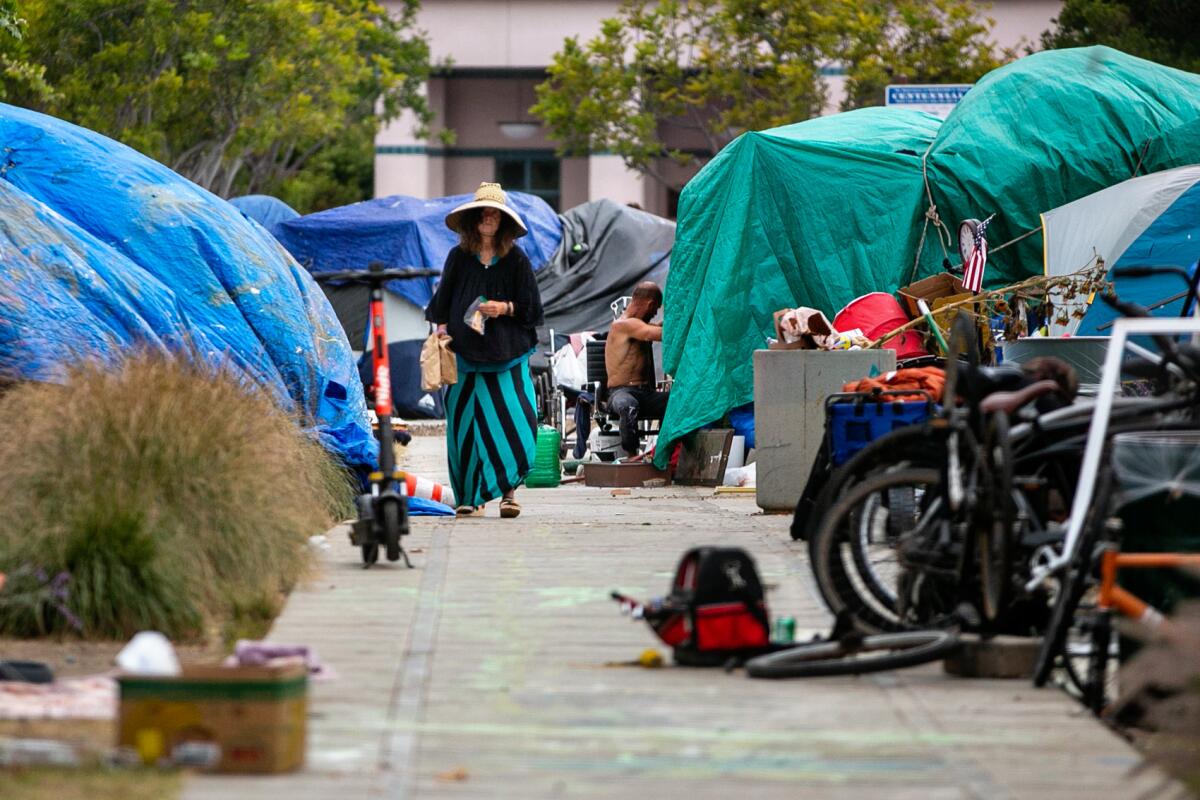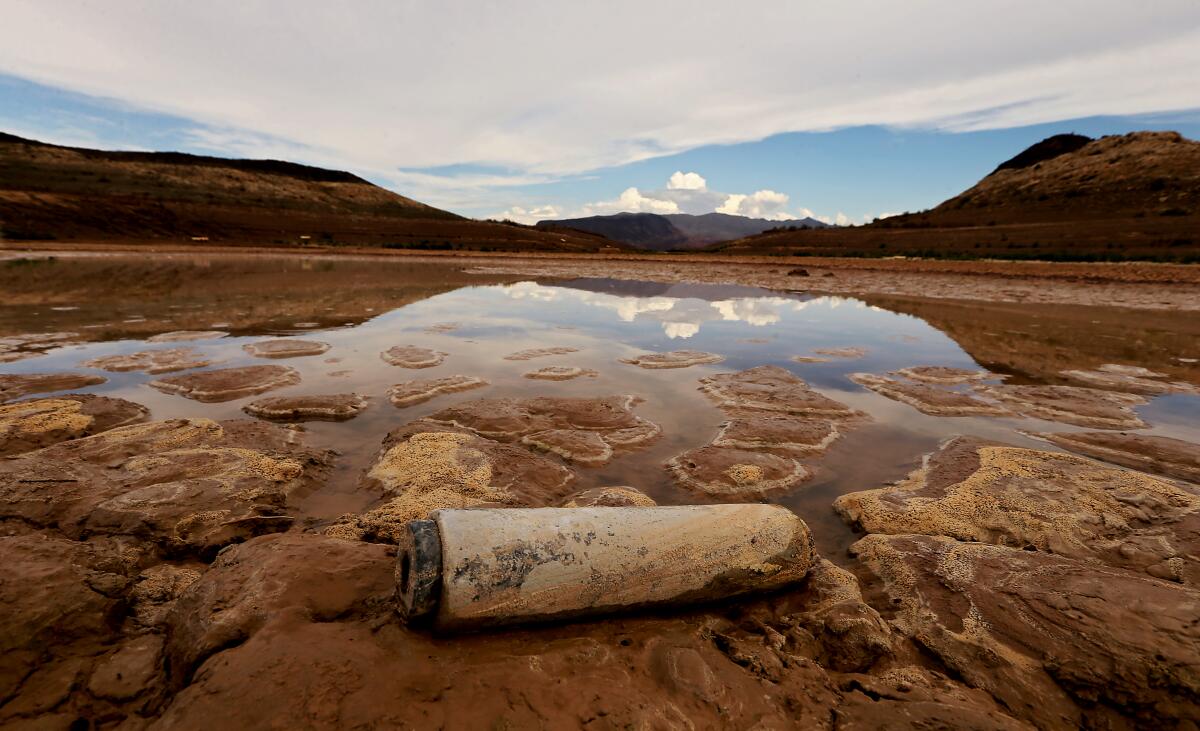L.A. mayoral candidates get specific about addressing homelessness

- Share via
Good morning, and welcome to the Essential California newsletter. It’s Sept. 6. I’m Ben Poston, an investigative reporter writing from the sweltering San Fernando Valley.
Homelessness has become a central issue of the Los Angeles mayoral race; more specifically, the question of what is the smartest, cheapest and most efficient way to provide housing to those living on the street.
L.A. mayoral candidates Rep. Karen Bass and developer Rick Caruso recently sat down with Times reporters and offered their most detailed plans to date on how they would address the homelessness crisis in a city where as many as 41,000 people sleep in tents, RVs and other makeshift housing.
What are the candidates’ approaches?
During her first year in office, Bass plans to squeeze current homelessness programs to expand interim and permanent housing for more than 17,000 people, at a cost of $292 million. Those folks would be placed in tiny homes, motels, hotels and available apartments. (Tiny homes are temporary, transportable structures measuring 8 feet by 8 feet that come with one, two or four beds.)
She would accomplish this by cobbling incremental improvements in several existing programs, including expanded use of housing vouchers and the leasing and purchase of motels and hotels, according to her nine-part plan. She would also build new shelter beds to accommodate about 1,000 people.
Caruso is more focused on constructing temporary housing at a larger scale. He wants to build 30,000 interim housing beds, at a cost of up to $843 million, in the first year. His plan is to build 15,000 interim beds in tiny houses on 300 government-owned parcels. He seeks to provide another 15,000 beds in the form of “sleeping pods” in existing structures, such as warehouses and vacant buildings.
[Read: “Bass and Caruso have talked big on homelessness. Now they’re offering some details,” in The Times.]
Where would the money come from?
Both plans would involve spending hundreds of millions of dollars beyond what the city and county already spend each year on homeless housing and services — money largely coming from two ballot measures approved several years ago by voters, augmented by state and federal funds.
The candidates say they can meet these additional costs by securing more federal and state funding, reducing construction costs and running things more efficiently.
Some current and former elected officials are skeptical about the feasibility of the candidates’ plans.
“I don’t think either of those plans will accomplish what they say they are going to accomplish in a year,” said Zev Yaroslavsky, director of the Los Angeles Initiative at the UCLA Luskin School of Public Affairs and a former city councilman and county supervisor. “I just don’t think it’s possible. I think it’s good to set the goal, [but] a plan is just a plan until you execute it.”
Yaroslavsky said he saw strong elements in both plans; he thinks the new mayor can succeed only by overcoming local political fragmentation. His solution is a countywide homelessness executive allowed to budget money and make land-use decisions.
“The city and the county have to come to the mountain,” said Yaroslavsky. “Let the city and the county create a new paradigm, set a new template of political collaboration and cooperation and effectiveness.”
For the politics junkies out there, Times reporters Benjamin Oreskes and Doug Smith charted out the details of the proposals from Bass and Caruso in a convenient side-by-side comparison.
[For more as the race for Los Angeles mayor unfolds, sign up for our L.A. on the Record newsletter.]
And now, here’s what’s happening across California.
Note: Some of the sites we link to may limit the number of stories you can access without subscribing.
L.A. STORIES

Southern California remains in the grip of the worst heat wave of the year — with scorching conditions expected through midweek. The conditions have heightened worries about wildfires and power interruptions. High temperatures of 105 to 110 degrees were reported Monday across the San Fernando, San Gabriel and Santa Clarita valleys. Officials issued another Flex Alert for California, calling for voluntary power conservation. Los Angeles Times.
Authorities pleaded with residents to conserve energy. Faced with the prospect of rolling blackouts, officials on Monday issued an urgent call for California residents to reduce their electricity usage. In response to a Flex Alert first issued last Wednesday, Californians have lowered their energy use by about 2%. But officials said two to three times as much was necessary. The key to avoiding blackouts Tuesday is reducing energy use in the hours of greatest consumption: late afternoon and evening, from 4 to 10 p.m. Residents are urged to set their thermostats to 78 degrees in the late afternoon. Los Angeles Times
Here’s a guide on how to stay safe during the heat wave. Stay informed by checking conditions on the National Weather Service’s website. Stay indoors and dress in light clothing. Stay hydrated and watch for heat-related illness in yourself and your loved ones. Los Angeles Times
Our daily news podcast
If you’re a fan of this newsletter, you’ll love our daily podcast “The Times,” hosted every weekday by columnist Gustavo Arellano, along with reporters from across our newsroom. Go beyond the headlines. Download and listen on our App, subscribe on Apple Podcasts and follow on Spotify.
POLITICS AND GOVERNMENT
A visit to the grocery, electronics or general retail store will fundamentally change for most California residents. That is, if Gov. Gavin Newsom signs half a dozen new bills that would further reduce and clean up the state’s plastic waste. One high-profile bill will affect the plastic bags in the produce and bulk bin sections of grocery stores. Starting in 2025, such bags will have to be reusable, recyclable or compostable. Other bills focus on waste generated by batteries, electronics and wine and spirits bottles. Los Angeles Times
Gov. Gavin Newsom signed a landmark law for fast-food workers on Labor Day. The measure will affect more than half a million fast-food workers in California and was signed despite the objections of restaurant owners who warned it would drive up costs, the Associated Press reports. The law sets a cap on minimum wages for fast-food workers at chains with more than 100 restaurants at $22 an hour next year, compared with the statewide minimum of $15.50 an hour. Associated Press
CRIME, COURTS AND POLICING
As the San Diego County D.A. considers college rape claims, experts explain why such cases are challenging. A month ago, San Diego police detectives sent prosecutors one of the most-watched criminal investigations in the county — allegations that a 17-year-old high school student was gang-raped by San Diego State University football players. It’s now up to the district attorney’s office to decide whether to file charges. Even after the #MeToo movement, with the attention and advancements it brought, struggles in investigating and prosecuting rape cases continue. San Diego Union-Tribune
The fast-moving Mill fire in Siskiyou County killed two people in Weed, Calif., authorities said. The blaze burned more than 100 homes and other buildings in the rural Northern California community, and emergency crews spent Sunday doing door-to-door assessments. The fire has burned more than 4,200 acres and is now 25% contained. “We have lost two people to this fire. There is no easy way of putting that,” Siskiyou County Sheriff Jeremiah LaRue told a community meeting Sunday. Los Angeles Times
Support our journalism
HEALTH AND THE ENVIRONMENT

What is a “dead pool”? Here’s a frightening real-world example: If the levels of Lake Mead and Lake Powell drop too low, water can no longer flow downstream through their dams, resulting in “dead pools.” That’s an existential problem for California, which has the largest water entitlement of any state on the Colorado River. Reducing the state’s use of the river could involve expanding drought restrictions in cities, increasing incentives for property owners to remove grass and paying farmers to cut the amount of water they use to irrigate their fields. Los Angeles Times
An algae bloom has turned the San Francisco Bay brown and green and killed thousands of fish. What’s fueling it? Get ready, the answer will gross you out: It’s the poop and pee flushed down the toilets by the Bay Area’s 8 million residents. Algae blooms require nutrients to grow, and even treated sewage has nitrogen and phosphorous in it when it’s discharged into the bay, according to the San Francisco Chronicle. The regional water board has told agencies that it will likely require limits on nutrients in wastewater by 2024. But upgrading dozens of aging treatment facilities could cost $14 billion, which would dramatically increase residents’ water bills. San Francisco Chronicle
CALIFORNIA CULTURE
Say it with me: “There is no such thing as a private beach in California.” Even if some areas of Malibu seem like they belong to well-heeled property owners, they don’t. For years, affluent homeowners have posted illegal “no trespassing” and “private beach” signs and hired security guards to scare people away.
“All that could make a visitor question whether they could legally access these treasured spots. But the general rule is that if you’re on wet sand at a beach in California, you can absolutely be there,” writes Times reporter Kailyn Brown. She also gives us a tour of 11 Malibu beaches you can definitely visit — even if they look private. Whether you need driving, parking or walking tips, she’s got you covered.
My favorite beach on the list is Nicholas Canyon, and there is an easily accessible hiking loop to Nicholas Flat Natural Preserve from the nearby Leo Carrillo Campground. Los Angeles Times
Free online games
Get our free daily crossword puzzle, sudoku, word search and arcade games in our new game center at latimes.com/games.
CALIFORNIA ALMANAC
Los Angeles: sunny, 94. San Diego: sunny, 86. San Francisco: sunny, 83. San Jose: sunny, 104. Fresno: sunny, 115. Sacramento: sunny, 114.
AND FINALLY
Today’s California memory is from Jorge Frias:
During the rainy winter of 1977-78, I remember waiting for the orange and gray RTD buses that would take my mom, sister and I from Boyle Heights to downtown L.A. We’d get off near 4th & Broadway, and we’d run for shelter into J.J. Newberry at the corner of 5th & Broadway. As we’d run, attempting to stay dry, I would look up and catch a glimpse of Chicken Boy watching over us. Entering Newberry, I would get hit with the smell of popcorn and pizza. That savory, greasy, pepperoni pizza served on wax paper still sits in my memory after all these years.
If you have a memory or story about the Golden State, share it with us. (Please keep your story to 100 words.)
Please let us know what we can do to make this newsletter more useful to you. Send comments to essentialcalifornia@latimes.com.
Sign up for Essential California
The most important California stories and recommendations in your inbox every morning.
You may occasionally receive promotional content from the Los Angeles Times.







